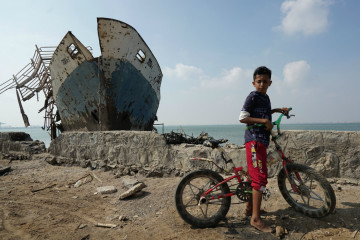

Concurrent cholera outbreaks and financial crises have further compounded Yemen's difficulties, forcing Yemeni officials to dedicate their limited resources to the most immediate problems. However, global warming may soon make itself felt across Yemen in ways hard for even combatants to ignore.
In 2014, a year before the outset of the Yemeni civil war, the World Bank concluded that the water table was already sinking by six metres per year in the countryside around Amran, Dhamar, Sadah, Sanaa, and Taiz. Other experts predicted that Sanaa would deplete its water supply by 2023.
The war in Yemen has only accelerated the spread of water scarcity across the country, and climate change will ensure that droughts and other environmental issues grow more relentless in the years to come.
"Climate change has affected most aspects of life in Yemen," observed Abdulhakim Aulaiah, a former official in the Environmental Protection Authority, a government agency within the Yemeni Water and Environment Ministry.
"Sea level rise is causing environmental issues in ports such as Aden and al-Hodeidah. As a result of unusually high temperatures, malaria is spreading. Fluctuations in rainfall have affected crop yield across Yemen. The supply of fish in the seas around Yemen is decreasing, and several species have vanished. Climate change is one of the biggest threats to biodiversity."
 |
The war in Yemen has only accelerated the spread of water scarcity across the country, and climate change will ensure that droughts and other environmental issues grow more relentless in the years to come |  |
In addition to water scarcity, global warming has aggravated gradual but serious environmental issues such as biodiversity loss, desertification, and sea-level rise in Yemen. In a handful of cases, climate change has already had deadly consequences for Yemenis.
Several cyclones have buffeted Yemen in the last few years. Back-to-back hurricanes hit the country in 2015, killing 26. The headline-grabbing battles of the war are obscuring the extent of environmental degradation's lethality.
"It's certain that Yemen is one of the countries most affected by climate change," Tawfeeq al-Sharjabi, the Yemeni Deputy Water and Environment Minister, told The New Arab.
"There have been notable differences in the seasons and the quantities of rainfall – in addition to the repeated hurricanes that have hit the Yemeni coasts, the high temperatures, and other environmental issues."
Amid one of the Middle East's most persistent conflicts, Yemeni officials have often struggled to respond to the dangers of climate change.
The Houthis still control Yemen's capital and its surroundings, and Yemeni militias – many of which continue to operate outside the command hierarchy of the Yemeni military – hold the most sway in several other cities. An ongoing financial crisis has further constrained the Yemeni government. Meanwhile, Saudi Arabia, the Yemeni government's wealthiest supporter, has sent the international community mixed signals on its commitment to slowing global warming.
 |
Global warming has aggravated gradual but serious environmental issues such as biodiversity loss, desertification, and sea-level rise in Yemen |  |
"The Yemeni government faces many economic and political problems, and it remains absent from quite a few of the liberated areas," Aulaiah told The New Arab, noting that the Yemeni civil war has hindered the Yemeni response to climate change.
"Many ministers spend most of their time outside the country. Some ministers and civil servants have academic degrees but no practical experience."
Militants have begun to exploit these weaknesses. Al-Qaeda in the Arabian Peninsula distributed water to Yemenis and repaired wells for them when it seized part of Yemen. Like-minded insurgents in other countries have taken a similar approach to environmental degradation: the Islamic State group [IS] employed the same strategy to recruit supporters on a much wider scale in Iraq while al-Shabaab, the Taliban, and Osama bin Laden himself referenced climate change in their propaganda for decades.
The Yemeni government and its supporters in Abu Dhabi and Riyadh have obvious military and political interest in stopping global warming from giving militants further opportunities to use environmental issues to recruit followers in Yemen. Saudi Arabia has even defined environmental security as part of national security, a standard that should apply no less to climate change in Yemen.
Because the war has inhibited the Yemeni government's ability to address global warming, the international community must move to assist the Yemeni Water and Environment Ministry with devising an effective response to environmental issues.
The United Nations Environmental Programme is supporting Yemeni scientists while the United States Agency for International Development and other aid agencies have dedicated millions of dollars to helping Yemenis deal with several humanitarian crises. The international community can adapt these ongoing efforts to the challenges of climate change.
The Yemeni government's allies need to provide more than military assistance. Saudi Arabia and the UAE, the two regional powers that enjoy the greatest influence in Yemen, have pioneered alternative energy. Given that countless Yemenis already rely on solar power as a replacement for the electric grids destroyed during the Yemeni civil war, Emirati and Saudi officials remain in a unique position to bolster the renewable energy industry in Yemen and prepare the country for global warming as a whole.
"Yemen has become so vulnerable to climate change because it is a developing country suffering from political instability," concluded al-Sharjabi, pointing to the distractions of the Yemeni civil war. "This ongoing challenge has severely limited Yemen's ability to cope with global warming's effects."




 Follow the Middle East's top stories in English at The New Arab on Google News
Follow the Middle East's top stories in English at The New Arab on Google News


